
|
|

March 23, 2007
The Big Trip 2006, Part VII: East From Portland
Once every year or so, when finances and schedules permit, your editor and a couple of his similarly-obsessed radio pals get together to spend a week or so exploring a corner of our great nation, packing our schedules as full as possible to visit as many interesting broadcast facilities as we can.
And then, a few months later, once we've caught our breath (and some much-needed sleep), we share it all with you here on Tower Site of the Week (and in audio form over on Tophour.com) in a feature we call "The Big Trip."
The 2006 version of the Big Trip began and ended in Seattle, and along the way took us as far south as Eugene, Oregon and as far east as Coeur d'Alene, Idaho.
Day Five - Monday, September 25
When we left off in the second part of our Portland visit last week, we were way out in Portland's eastern suburbs, touring the historic transmitter site of KEX (1190), which has more recently become home to sister station KPOJ (620) as well.
Those are two of Portland's biggest AM signals, and our next stop after we leave that site is to do a drive-by visit of another big Portland AM site. KXL (750) is a venerable Portland AM, having signed on way back in 1926 as a 50-watter, with a long, colorful road to today's 50 kW day/20 kW night operation. Before the 1941 NARBA shuffles, KXL spent more than a decade on what was then the graveyard frequency of 1420, sharing time with high school station KBPS, which we saw last week. In October 1941, KXL moved down the dial to 750, becoming a 10 kW daytimer, with some additional night operation after Atlanta's WSB had signed off for the night. (Such limited west coast night licenses were not uncommon; 1020 in Los Angeles and 1100 in San Francisco were among the stations with similar authorizations.)
KXL went to 50 kW daytime operation in 1960, and in 1977 it lost its longtime transmitter site (just north of the KEX site, on the other side of I-205) to the development that would become the Clackamas Town Center mall. KXL relocated to Damascus, Oregon, about 6 miles east of its old site, and built the site it uses today, with two 337-foot towers and two 289-foot towers. In 1984, KXL finally went fulltime, initially with 1 kW at night, and later with 10 and then 20 kW. Since 1998, KXL has been the flagship property of Rose City Radio, owned by Paul Allen, the Microsoft co-founder who now owns the Portland Trail Blazers, among other things.
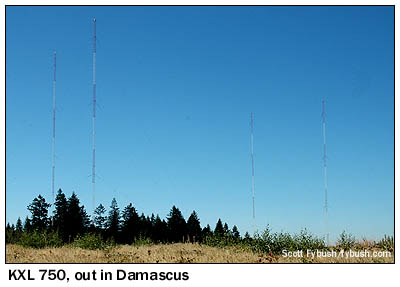
|

|
From KXL's rural site, out beyond metro Portland's "urban growth boundary" (ask a Portlander about that if you want to start a long conversation!), we head back into suburbia to meet up once more with our friend and tour guide Kent Randles, K7YXZ, for lunch and a few more tours before we say our farewells to Portland and head on to our next markets.

|
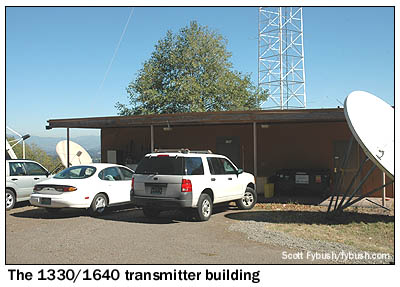
|
Our first stop after lunch is at the only significant (former) FM site on the east side of Portland. Mount Scott, a butte rising 1050 feet above sea level (30 feet or so higher than the Stonehenge tower site, and just 20 feet shy of being the highest spot in Portland) just east of I-205 and about eight miles southeast of downtown Portland, became an FM transmitter site in June 1948, when KPOJ-FM (98.7, later 98.5) signed on up here from what's now the center tower of the KKPZ (1330) directional array. KPOJ-FM was the sister to AM 1330, which had been a sister station to KOIN under the calls KALE in the thirties; it moved from KOIN's Sylvan site up here to Mount Scott in 1948 and changed its calls to KPOJ(AM) later that year.
Those calls, which stood for the now-defunct Oregon Journal afternoon newspaper, lasted on 1330 for many years, though by the early seventies it and its sister FM (both briefly known as KPOK) had become KUPL and KUPL-FM, one of the market's country giants.
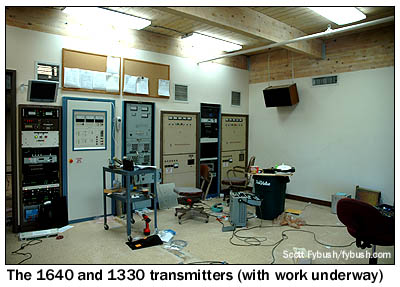
|

|
In time, more towers sprouted up here on Mount Scott. KMJK (106.7 Lake Oswego) went on the air from a separate Mount Scott site in 1977, after the sad demise of the original 106.7, KQIV, which used a different site. (You can read all about KQIV's fascinating history at the fantastic rockininquad.com website.) It remained on Mount Scott until 1997, when (as KKJZ) it relocated to Sylvan.
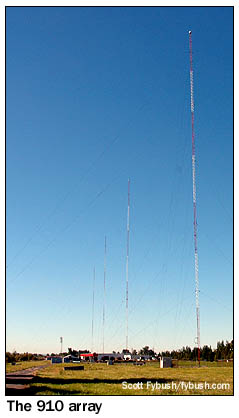
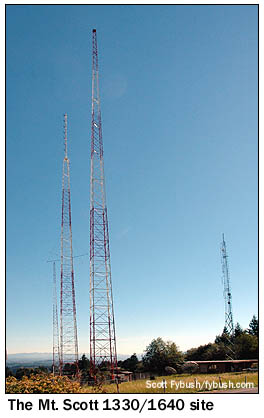 Also up here, on
yet another tower, was what's now KNRK (94.7 Camas WA), which
now broadcasts from the very top of Stonehenge.
Also up here, on
yet another tower, was what's now KNRK (94.7 Camas WA), which
now broadcasts from the very top of Stonehenge.
There's no more KUPL-FM up here now, either; in 1997, it moved from 98.5 back to 98.7, eliminating an IF-spacing issue with the audio carrier of KOIN-TV (Channel 6), and relocated to the Sylvan site.
Today, Mount Scott's various towers are home to lots of two-way, a few LPTVs, and two AMs: 1330 is now KKPZ, "Praise 1330," a Crawford religious outlet, sharing one tower of its three-tower array with the market's Radio Disney signal, KDZR (1640 Lake Oswego).
That X-bander is the descendant of the old KLIQ (1290), which started out over at Oaks Park, then spent the rest of its life sharing the 1520 (ex-KYXI, ex-KGON, ex-KFXX, now KGDD) site not far from KEX.
1290 finished its existence as KKSL, a sister station to KKPZ, before signing off in favor of the X-band outlet in 2005. (Disney was actually LMA'ing 1290 back to Crawford at the end.)
When we visit the 1330/1640 site, engineer John White is hard at work on KKPZ's Nautel (at center in the photo above), so 1330's running on one of its older Continentals, while 1640 chugs along on the Nautel at left. John takes a few minutes to give us a tour of the place, including the view out the window to Mount Hood in the distance and to the big skirted antenna around the 437' center tower (those are 20-foot arms spacing the folded unipole out from the tower). 1640 is diplexed into the tower in the foreground in the photo above; it's a typical 10 kW day/1 kW night X-bander, though it once held a CP to go 10 kW at night from all three towers.
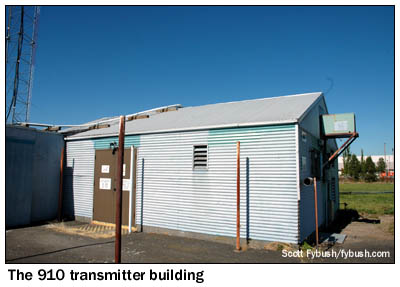 With
thanks to John for the visit, we say our farewells and make our
way north toward the Columbia River and our last two Portland
AM sites of the day.
With
thanks to John for the visit, we say our farewells and make our
way north toward the Columbia River and our last two Portland
AM sites of the day.
KISN (910 Vancouver WA) was the big top 40 outlet in the market when it moved to its present four-tower site, about two miles east of the Portland airport, in 1966, relocating from an earlier site near Smith Lake, also along the Columbia River to the west. KISN lost its license in 1976 as part of the FCC's refusal to renew any of the licenses held by its owner, Don Burden, who was accused of using his stations' newscasts to favor particular political candidates.
It returned under new ownership and with new, similar calls, KKSN - and after several other formats and calls (sports KFXX, talk "Max" KOTK), 910 is once again KKSN and playing oldies when we arrived there on that warm September afternoon. (The "Kisn" oldies format had recently returned to the AM dial after a long stretch on 97.1, which had recently flipped to adult hits as "Charlie FM" KYCH.)
Stepping inside the front door, we're greeted by some nice vintage transmitters: a Rockwell Collins Power Rock that's the main, and a 5 kW Bauer that's still a working auxiliary. (Just to prove the point, Kent fires it up for us, and those tubes sure do look nice in there, don't they?)
Alas, the oldies didn't last much longer at 910: in January 2007, Entercom sold the station to Salem, which flipped it to talk as KTRO, simulcasting its FM talker, KTRO-FM 93.1 Gladstone.
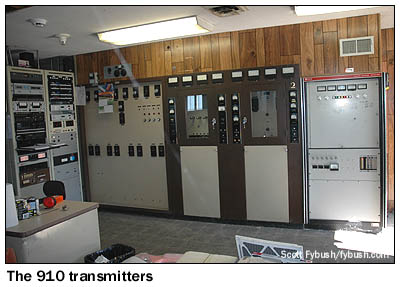
|
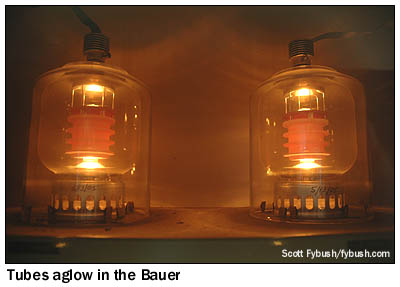
|
From the 910 site, it's only half a mile or so east to the three towers of Portland's AM 1080, known for most of its life as KWJJ. As we mentioned last week, KWJJ (then on 1040) went on the air in 1936 from Oaks Park, then moved to Smith Lake in 1948. In 1966, KWJJ abandoned the Smith Lake site and moved to this site off Marine Drive, with its most unusual cylindrical transmitter building. A decade or so later, KWJJ replaced a five-tower array at this location with its current 208-foot top-loaded towers
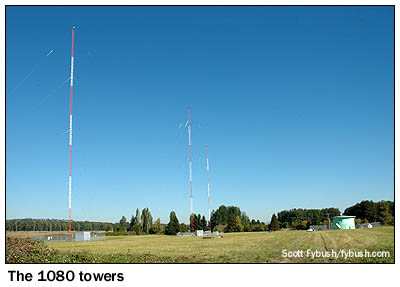
|

|
The ground floor is used for storage, and a curved stairway leads up to the good stuff on the second floor, where a wall (painted bright orange) separates the equipment racks from the transmitters - a Continental 317 and, beyond it, a Harris DX50 tucked in the corner. There's a second-floor doorway around the back of the building that allows for the transmitters and phasor and other big equipment to be hoisted in, so there's no tricky lifting up that narrow stairway. (And, yes, this is a floodplain...)
1080's now all-sports KFXX, a format and a set of calls that have migrated around the dial from 1520 to 910 to 1080, where they replaced talk KOTK; the KWJJ calls live on, of course, at 99.5 on the FM dial.
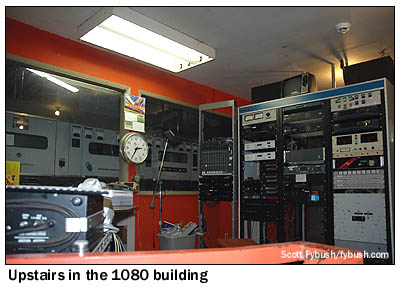
|

|
It's here that we say goodbye to Kent, and to Portland. There's much left unseen, including a whole cluster of AM sites on the Washington State side of the market, and we will surely be back at some point to see more of the sites in this wonderful market. Now, though, we're taking advantage of a few remaining hours of daylight to make the scenic drive east on I-84 through the Columbia River Gorge, stopping first at the Bonneville Dam hydroelectric plant (where you can watch the salmon swim through the fish ladder down below water level), then in the small town of Hood River, 65 miles east of Portland. KIHR (1340) and KCGB (105.5) are the local commercial stations, and they're in a little house on a hill just southwest of downtown.
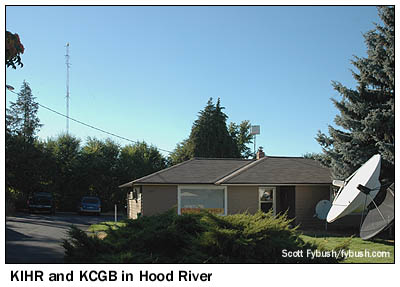
|

|
From Hood River, we cross the Columbia to Washington State, driving some 30 miles along the river's north shore and then crossing the river once more to enter The Dalles, Oregon, the commercial hub of the Gorge region.
The Dalles has been in the news in the radio engineering community lately because of the impending move of its big class C FM signal, KMCQ (104.5). It will soon leave this town behind and move to a new city of license of Covington, Washington, which just happens to be a suburb of Seattle, 100 miles and several mountain ranges to the northwest - but for now, it's still local to the The Dalles, with studios on E. Second Street downtown.
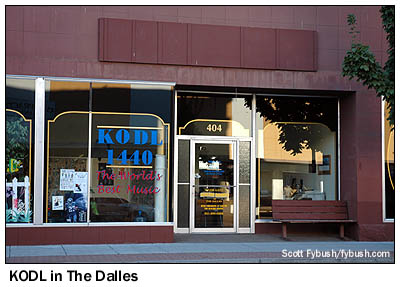
|
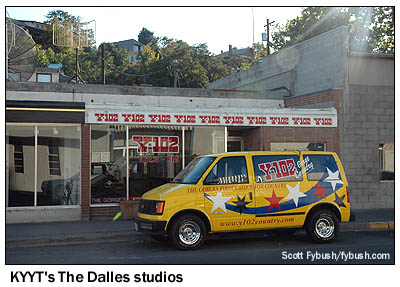
|
A block to the south is the studio of KYYT (102.3 Goldendale WA), and three blocks west is the studio of KODL (1440 The Dalles). With daylight rapidly running away from us, we skip that AM site, up in the hills south of town, as well as the site of The Dalles' other AM, KACI (1300), in the hills southeast of downtown. KACI also has two FM sisters, KACI-FM (97.7 The Dalles) and KMSW (92.7 The Dalles), and we don't make it to those sites, either, or to the Columbia Gorge Broadcasting studios in an office building downtown.
Instead, we keep moving east, as the gorge gives way to the desert that is eastern Oregon, passing through Umatilla as the sun sets and ending our day in Walla Walla, Washington. In next week's installment, we'll see the sites of Walla Walla and the Tri-Cities - and be sure to visit Tophour.com beginning Wednesday, March 28 to hear the legal IDs of Hood River, The Dalles, Umatilla and Hermiston!
 The
Tower Site Calendar 2007 is here! They're about to sell out,
just like 2006 did - order today at the Fybush.com
Store!
The
Tower Site Calendar 2007 is here! They're about to sell out,
just like 2006 did - order today at the Fybush.com
Store!
- Previous Site of the Week: Downtown Portland Studios and KEX
- Next Week: Walla Walla and Tri-Cities, Washington
- Site of the Week INDEX!
- How can you help support Site of the Week? Click here!
- Submit your suggestions for a future Site of the Week!
